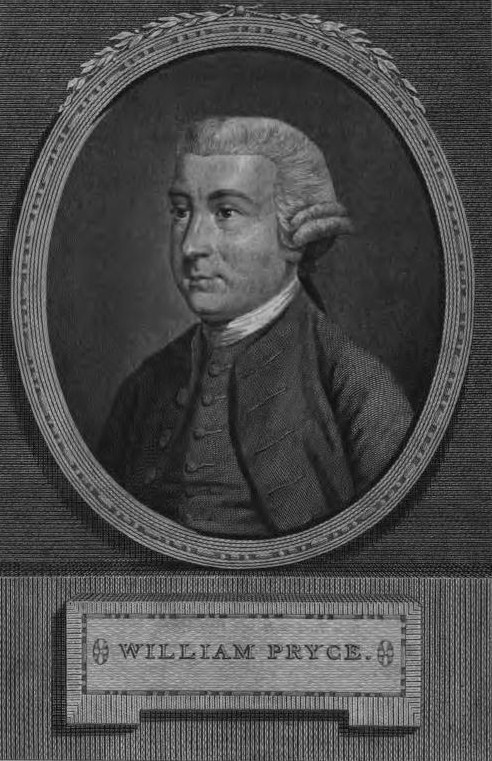William Pryce on:
[Wikipedia]
[Google]
[Amazon]
William Pryce (baptised 1735–1790) was a British medical man, known as an antiquary, a promoter of the Cornish language and a writer on 
mining in Cornwall
Mining in Cornwall and Devon, in the southwest of England, began in the early Bronze Age, around 2150 BC. Tin, and later copper, were the most commonly extracted metals. Some tin mining continued long after the mining of other metals had be ...
.

Life
He was the son of Dr. Samuel Pryce of Redruth inCornwall
Cornwall (; kw, Kernow ) is a historic county and ceremonial county in South West England. It is recognised as one of the Celtic nations, and is the homeland of the Cornish people. Cornwall is bordered to the north and west by the Atlantic ...
, and Catherine Hill; William Borlase
William Borlase (2 February 169631 August 1772), Cornish antiquary, geologist and naturalist. From 1722, he was Rector of Ludgvan, Cornwall, where he died. He is remembered for his works ''The Antiquities of Cornwall'' (1754; 2nd ed., 1769) ...
was a great-uncle on his mother's side. Philip Webber of Falmouth acted as his guardian when he was left an orphan. He claimed to have studied anatomy under John Hunter, and from about 1750 he practised as a surgeon and apothecary at Redruth.
Pryce owned a small share in the copper mine of Dolcoath in Cornwall. For ten years he was also an investor in the adjoining mine of Pednandrea, which was worked for both tin and copper. It was near the future site of the Redruth railway station
Redruth station serves the town of Redruth, Cornwall, United Kingdom, and is situated on the Cornish Main Line between Truro and Camborne. The station is from via .
Great Western Railway manage the station and operate most of the trains, with ...
.
Soon after 1778 Pryce "became M.D. by diploma" and on 26 June 1783 he was elected Fellow of the Society of Antiquaries of London
A fellow is a concept whose exact meaning depends on context.
In learned or professional societies, it refers to a privileged member who is specially elected in recognition of their work and achievements.
Within the context of higher education ...
. He was buried at Redruth on 20 December 1790.
Works
Pryce published his major work, the ''Mineralogia Cornubiensis'', in 1778. It was a study of the mining world of Cornwall, historical and practical. A second work, ''Archæologia Cornu-Britannica'', was published in 1790. It contained a Cornish language vocabulary of 64 page, and a grammar. Much of the material was taken directly from the collections of Thomas Tonkin and William Gwavas, as acknowledged in the preface.Family
Pryce married Miss Mitchell of Redruth, and left two sons, William Pryce and Samuel Vincent Pryce, both of whom became surgeons there.Notes
;AttributionExternal links
* {{DEFAULTSORT:Pryce, William 1735 births 1790 deaths English surgeons English apothecaries 18th-century English medical doctors English antiquarians Fellows of the Society of Antiquaries of London People from Redruth